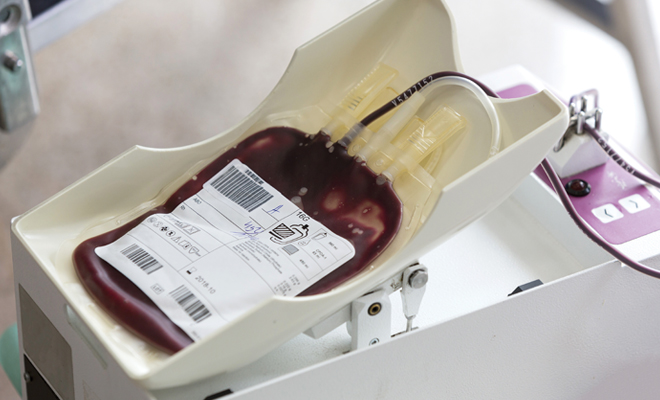
January: National Blood Donor Month
Leslie knows the deal. She walks into the church at the end of her street and finds the welcome table. The two ladies behind it finish up some small talk and greet Leslie with a warm smile. “Donating blood today?” one of them asks. “Yes!” Leslie exclaims as she hands over her donor card.
She is quickly directed to another area to answer a few questions, get her finger pricked and blood pressure taken. Soon she is lying down and her favorite technician is taking blood from her left arm. Finished in less than 45 minutes, Leslie can now relax with complimentary cookies and drinks.
Every two seconds someone needs blood, and frequent blood donors make certain that blood is waiting for them. While accident victims need blood, most blood is used for people with cancer or other illnesses, or people who need surgery.
Whether a patient receives whole blood, red cells, platelets or plasma, this lifesaving transfusion begins with someone making a fairly simple donation.
The most common donation is whole blood. It can be transfused in its original form, or used to help multiple people when separated into its specific components of red cells, plasma and platelets. Usually, one pint of whole blood is donated, and the actual “needle time” is no longer than ten minutes. Donors must wait 56 days between donations.
With a plasma donation, plasma is separated from the other components by a special machine in a process called apheresis The red blood cells are returned to the donor in cycles throughout the process. Platelet donation is done similarly to plasma donations, but both the red blood cells and plasma are transferred back to the donor. Often called “liquid gold,” the platelets are a shiny yellow color and they’re vital for many patients. One platelet donation is worth several transfusable units. Plasma and platelet donations take about an hour and a half to two hours, and both types of donations can be made weekly up to 24 times a year.
The Power Red or Double Red donation is a 30-minute process that takes twice as many red blood cells than a whole blood donation. Red cells from these donations are typically given to trauma patients, newborns, people with sickle cell anemia and anyone suffering blood loss. Donors can give blood this way every 16 weeks.
All blood types are needed, but particularly O positive, O negative, A negative and B negative. Generally, to be eligible to donate blood, plasma or platelets you must be at least 110 pounds, in good health and at least 16 or 17 years old, depending on where you live. Requirements vary slightly for different types of blood donation and from center to center. Some states allow minors to donate with a parent’s permission. While there is no upper age limit for donating, donors need to be healthy with no restrictions or limitations to daily lifestyle.
Giving blood is not only beneficial for the receiver but for those who donate as well. Regular donors reduce their chances of heart attack and keep iron levels steady. Anyone who donates also receives a wellness checkup that includes blood pressure, pulse, temperature, iron count and a cholesterol screening. Those interested in donating blood or becoming a more consistent donor should check with local groups, churches and organizations Such as the American Red Cross for their donation schedule. Donors can also search blood drives online by ZIP code.
Most people can give blood safely and easily. However, a small percentage of people are not good candidates. Having cancer, blood diseases or low body weight generally make donating unsafe. Because of hepatitis concerns, some states ask donors to wait at least one year after getting a tattoo or piercing before giving blood. The same waiting period is also asked of people who have traveled to countries that are considered at risk for malaria. If someone doesn’t feel well on the day they are supposed to donate, they should cancel their donation or wait 24 hours after symptoms have passed.
Numerous blood donation organizations offer recognition and milestone pins for donors who go the extra mile. Donors often set their own milestone goals, motivating them not only to reach certain donation levels but also to maintain a regular giving schedule.
Here’s the thing about blood. We always need it. This year, about 1.7 million people will be diagnosed with cancer, and most of them will need blood continually during their treatment. If your neighbor or your neighbor’s kid has a car accident, he may need as much as 100 pints of blood to survive. Do it to be helpful; do it in honor of a friend; or just do it for the free cookies and drinks. ■
Sources: redcross.org, inovablood.org and mayoclinic.org.







